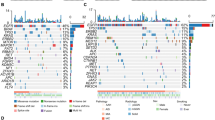Abstract
Flow cytometric (FCM) analysis of tumor DNA ploidy and S-phase fraction (SPF) has been widely used to predict prognosis and treatment response in many malignant tumors, but rarely in small-cell lung cancer (SCLC). In the present study, tumor DNA ploidy and SPF were measured from paraffin-embedded tumor biopsy samples of 36 small-cell lung cancer patients treated with combination chemotherapy and radiotherapy. Aneuploidy was detected in 69% of the tumors. There was a statistically non-significant trend towards more aneuploidy among extensive disease (ED) patients as compared to patients with limited disease (LD): 80% versus 65%, respectively (p = 0.69). The mean SPF was 213% (± 7.6) in patients with LD and 29.0% (± 5.3) in patients with ED, the difference (7.6%) being statistically significant(p = 0.008, 95% CI for the difference 2.2-13.1). No significant differences was detected in the survival of aneuploid and diploid patients or patients with low (⩽24.9%) and high (>24.9%) SPF. Similarly, no significant difference was observed between aneuploid and diploid cases in relation to response to treatment or response duration. It is concluded that the difference detected in the SPF with LD and ED of SCLC may indicate the biological aggressiveness of extensive SCLC.
Similar content being viewed by others
References
Souhami, R.L. and Law, K. (1989) Longevity in small cell lung cancer. A report to the lung cancer subcommittee of the United Kingdom coordinating committee for cancer research.Br. J. Cancer 61, 584–9.
Lassen, U., Österlind, K., Hansen, M., Dombernowsky, P., Bergman, B. and Hansen, H.H. (1995) Long-term survival in small-cell lung cancer: post-treatment characteristics in patients surviving 5 to 18+ years-an analysis of 1714 consecutive patients.J. Clin. Oncol. 13, 1215–20.
Feld, R. and Sagman, U. (1995) Prognostic factors in small cell lung cancer.Semin. Rad. Oncol. 5, 27–32.
Rawson, N.S.B. and Peto, J. (1990) An overviwe of prognostic factors in small cell lung cancer. A report from subcommittee for management of lung cancer of United Kingdom coordinating committee on cancer research.Br. J. Cancer 61, 597–604.
Bunn, P.A., Carney, D.N., Gazdar, A.F., Whang-Peng, J. and Matthews, M.J. (1983) Diagnostic and biological implications of flow cytometric DNA content analysis in lung cancer.Cancer Res. 43, 5026–32.
Tirindelli-Danesi, D., Teodori, L., Mauro, F.et al. (1987) Prognostic significance of flow cytometry in lung cancer. A 5-year study.Cancer 60, 844–51.
Ten Velde, G.P.M., Schutte, B., Vermeulen, A., Volovics, A., Reyneders, M.M.J. and Blijham, G.H. (1988) Flow cytometric analysis of DNA ploidy level in paraffin-embedded tissue of non-small-cell lung cancer.Eur. J. Cancer Clin. Oncol. 24, 455–60.
Salvati, F., Teodori, L., Gagliardi, L., Signora, M., Aquilini, M. and Storniello, G. (1989). DNA flowcytometric studies of 66 human lung tumors analyzed before treatment. Prognostic implications.Chest 96, 1092–8.
Ojala, A., Kallioniemi, O.-P., Wigren, T., Kallioniemi, A.et al. (1990) Flow cytometric analysis of tumour DNA profile related to response of radiotherapy and survival in inoperable lung cancer.Acta Oncol. 29, 983–8.
Salvati, F., Teodori, L., Trinca, M.L., Pasquali-Lasagni, R. and Göhde, W. (1995) The relevance of flowcytometric DNA content in the evaluation of lung cancer.J. Cancer Res. Clin. Oncol. 120, 233–9.
Visakorpi, T., Holli, K. and Hakama, M. (1995) High cell proliferation activity determined by DNA flow cytometry and prognosis in epidermoid lung carcinoma.Acta. Oncol. 34,605–9.
Volm, M., Martern, J., Sonka, J., Vogt-Schaden, M. and Wayss, K. (1985) DNA distribution in non-small cell lung carcinomas and its relationship to clinical behavior.Cytometry 6, 348–56.
Volm, M., Drings, P., Martern, J., Sonka, J., Vogt-Moykopf, I. and Wayss, K. (1985) Prognostic significance of DNA patterns and resistance-predictive tests in non-small cell lung carcinoma.Cancer 56, 1396–403.
Volm, M., Hahn, E.W., Mattern, J., Muller, T., Vogt-Moykopf, I. and Weber, E. (1988) Five-year follow-up study of independent clinical and flow cytometric prognostic factors for survival of patients with non-small cell lung carcinoma.Cancer Res. 48, 2923–8.
Abe, S., Makimura, S., Itabashi, K., Nagai, T., Tsuneta, Y. and Kawakami, Y. (1985) Prognostic significance of nuclear DNA content in small cell carcinoma of the lung.Cancer 15, 2025–30.
Carey, F.A., Prasad, U.S., Walker, W.S., Cameron, E.W.J., Lamb, D. and Bird, CC (1992) Prognostic significance of tumor deoxyribonucleic acid content in surgically resected small-cell carcinoma of the lung.J. Thorac. Cardiovasc. Surg. 103, 1214–7.
Miller, A.B., Hoogstraten, B., Staquet, M. and Winkler, A. (1981) Reporting results of cancer treatment.Cancer 47, 207–14.
Hedley, D.W., Friedlander, M.L., Taylor, I.W., Ruff, CA. and Musgrove, E.A. (1983) Method for analysis of cellular DNA content of paraffin-embedded pathological material using flow cytometry.J. Histochem. Cytochem. 31, 1333–5.
Kallioniemi, O.P., Visakorpi, T., Holli, K., Heikkinen, A., Isola, J. and Koivula, T. (1991) Improved prognostic impact of S-phase values from paraffin-embedded breast and prostate carcinomas after correcting for nuclear slicing.Cytometry 12, 413–21.
Abe, S., Tsuneta, Y., Makimura, S., Itabashi, K., Nagai, T. and Kawakami, Y. (1987) Nuclear DNA content as an indicator of chemosensitivity in small-cell carcinoma of the lung.Anal. Quant Cytol. Histol. 9, 425–8.
Oud, P.S., Pahlplaz, M.M.M., Beck, J.L.M., Wiersma-van Tilburg,A., Wagenaar, S.J. and Vooijs, G.P. (1989) Image and flow DNA cytometry of small cell carcinoma of the lung.Cancer 64, 1304–9.
Author information
Authors and Affiliations
Rights and permissions
About this article
Cite this article
Virén, M.M.T., Ojala, A.T., Kataja, V.V. et al. Flow cytometric analysis of tumor DNA profile related to response to treatment and survival in small-cell lung cancer. Med Oncol 14, 35–38 (1997). https://doi.org/10.1007/BF02990943
Issue Date:
DOI: https://doi.org/10.1007/BF02990943




